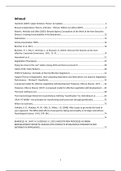Samenvatting
Samenvatting TMPS
- Vak
- TMPS
- Instelling
- Vrije Universiteit Amsterdam (VU)
Hambrick (2007): Upper Echelons Theory: An Update 2 Resource Dependence Theory: A Review – Hilman, Withers & Collins (2009) 6 Roberts, McNulty and Stiles (2005): Beyond Agency Conceptions of the Work of the Non-Executive Director: Creating Accountability in the Boardroom 12 Gabrielsson 14 Art...
[Meer zien]





